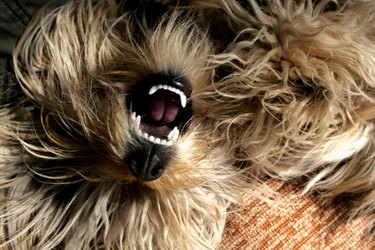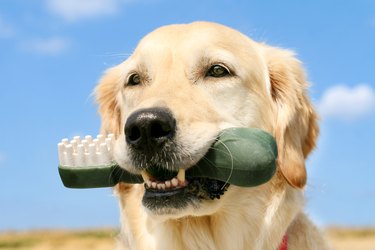Just as plaque forms on human teeth, it also forms on canine teeth. Plaque can harden into tartar, and if that isn't removed, it can lead to painful dental disease and even serious illnesses. Plaque is full of bacteria that can cause gingivitis, gum pockets, pain, and tooth loss. Oral bacteria can travel through the blood to the major organs, causing health problems in the heart, kidneys, and liver. There are a number of ways to remove plaque on dog teeth and prevent plaque so your favorite companion can stay healthy and comfortable.

Video of the Day
Causes of plaque and tartar buildup in dogs
Like humans, dog mouths contain bacteria. When these bacteria feed on the carbohydrates left over in a dog's mouth after they have eaten, they form the sticky biofilm on the teeth known as plaque. These bacteria also produce acid, which isn't good for dental enamel or gum tissue.
Video of the Day
Since plaque is constantly forming, it needs to be removed to prevent tartar. If plaque isn't removed on a regular basis, it combines with the minerals in your dog's saliva to form the hard yellow to brown material known as tartar. With ongoing tartar buildup, dogs can develop gum disease and potentially tooth loss.

Signs and symptoms of plaque on dog teeth
Since your dog can't tell you that they have that sticky or fuzzy feeling on their teeth caused by plaque, there are some other signs to look for. Common signs and symptoms of plaque are:
- Chronic bad breath
- Red/inflamed gums
- Swollen gums
- Bleeding gums
When plaque turns into tartar, you'll see a hard yellow to brown layer over part or all of the affected teeth. With enough tartar accumulation, the gum line can pull away from teeth and recede (gingival recession). This can expose part of a tooth's root, causing periodontal disease, which is damage to the surrounding connective tissue and bone.
Even if your dog sits well to have their mouth explored, it's not possible to identify all dental issues this way. This is one of the reasons veterinarians anesthetize dogs to perform a complete and thorough dental exam. If your dog has painful gums, receding gums, a loose tooth or teeth, or has already lost a tooth or teeth, you may notice signs such as:
- Dropping food out of their mouth
- Chewing on one side of their mouth
- Chewing awkwardly or slowly.
- Drooling
- Pawing at the mouth
- Not chewing food, especially kibble, and just gulping it down
- If your dog has lost a tooth, you may not find it because they sometimes swallow them.

How to get rid of plaque on a dog's teeth
Below are several ways to help reduce plaque in your dog's mouth. Keep in mind that in order to remove plaque, some sort of physical scrubbing action needs to occur.
Brush your dog's teeth at least twice a week
Before you dive in with getting plaque off your dog's teeth, you'll need to introduce them to a toothbrush and toothpaste. (Only use toothpaste that is made for dogs. Human toothpaste can contain ingredients that are toxic to pets.)
To start, let your dog lick the toothpaste off the toothbrush and then slowly work up to brushing a few teeth. You can even make a game out of it, where your dog is rewarded with attention or play time afterward. If your dog gets frustrated, stop. You want this to be a positive experience, so don't force or restrain your dog. Definitely don't punish them if they don't cooperate.
Brush your dog's teeth at least twice a week and preferably every day. Use a dog toothbrush, which is designed with a longer handle to better reach the back teeth. Initially, you can use a finger brush, but eventually, you want your dog to "graduate" to a regular bristle brush because it's more effective than the shorter, softer bristles on a finger brush.
Gently lift the dog's lips on one side and brush the side teeth. Stop for a few seconds and begin again. Lift the lips on the other side and brush the exposed teeth. Take breaks and offer a treat. Continue until you have brushed all the teeth.

Provide your dog with plenty of items to chew
Edible chews, such as rawhide; dental dog treats, like dental sticks; Greenies; and pig ears are enjoyable for most dogs. Chew toys are another choice. Add some peanut butter to the toy to increase their willingness to chew. The downside of peanut butter, however, is that it is sticky and will adhere to the teeth for a while.
Supervise your dog when giving any sort of edible chew because your dog can choke if a piece breaks off. It's also possible for them to swallow a piece, which can potentially become lodged somewhere in the digestive tract.
Give your pup the right types of foods
Though dry dog food can have a mild effect on reducing tartar, this mainly occurs near the top of the tooth and not so much at the gum line where most tartar accumulates. Larger kibble size can help with reducing tartar, as can dental diets designed to physically remove tartar from teeth. But if your dog gulps food without swallowing, dental diets or larger kibble (to encourage a dog to chew) are not going to work. Also, a larger kibble size for dogs who don't chew can become a choking hazard. A dog with dental pain may not chew their food.
If you don't want to switch your dog to a dental diet, consider adding some dental kibble as a treat. It's likely that your veterinarian carries at least one brand of a dental diet, or they can order it for you. If your dog eats canned or wet food, you don't need to stop feeding these foods if your dog receives regular home dental care.
Use a chlorhexidine oral rinse or gel
Chlorhexidine dental products for dogs, such as oral gels, rinses, and water additives, cut down on bacteria in the mouth. This helps prevent plaque and gingivitis, but these products don't remove plaque. Plaque removal requires physical scrubbing, such as with a toothbrush.
When using a chlorhexidine dental rinse, squirt the liquid inside your dog's cheeks. If using a gel, rub it on the teeth. As your dog moves their tongue and lips, the product will spread throughout the mouth. These dental hygiene products are available in pet stores and at your veterinary clinic. The Veterinary Oral Health Council (VOHC) recommends only purchasing products with a VOHC seal because the efficacy of these oral hygiene products has been verified. Look for this seal on pet dental chews, treats, and diets as well.

Preventing plaque on dog teeth
Depending on your dog, they will need a dental exam and professional dental cleaning once to twice a year. In order to do a complete dental exam, your dog will undergo general anesthesia. This is the only way to:
- Probe for dental pockets under the gum line.
- Take dental X-rays to evaluate the entire tooth and surrounding ligament and bone.
- Remove plaque beneath the gums, where it causes the most health problems.
- Thoroughly scale and polish the teeth.
Anesthesia also allows your veterinarian to check for oral tumors or other abnormalities.
Because it takes time to recover from anesthesia, pet parents should expect their dog to be at the veterinarian's office for the day. Your veterinarian will also determine the best dental cleaning schedule to keep your pet's teeth clean and healthy.
The bottom line
Plaque buildup is a sticky film that is constantly being formed in the mouth by bacteria. This happens after oral bacteria feed on carbohydrates from food debris left in the mouth. If plaque isn't regularly removed with brushing or some other activity that helps scrub the teeth, then it will combine with minerals in your dog's saliva to form the hard substance known as tartar. If your dog's breath is bad or they have red swollen gums, they might have plaque. Dogs with tartar will have yellow to brown matter on their teeth as well. Talk with your veterinarian about dental health at your pet's next physical exam.